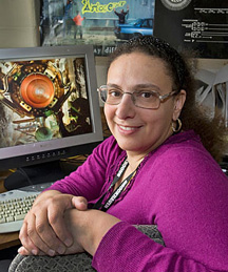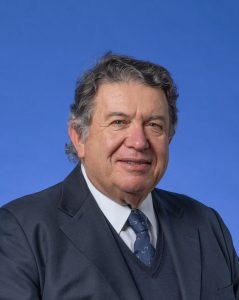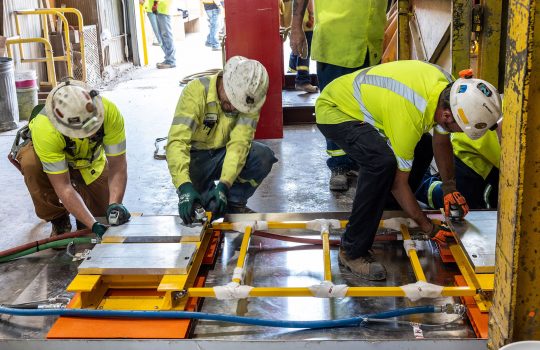Mary Bishai, an experimental particle physicist at the U.S. Department of Energy’s Brookhaven National Laboratory, is the new co-spokesperson for the Deep Underground Neutrino Experiment, a one-of-kind experiment to study neutrinos, elusive particles that hold the key to some of the universe’s greatest mysteries. She joins Sergio Bertolucci, professor of physics at the University of Bologna in Italy, who became co-spokesperson in 2022.
DUNE, hosted by DOE’s Fermi National Accelerator Laboratory, is an international effort aimed at addressing some of the biggest open questions in physics, such as the role neutrinos play in the evolution of the universe and the relationship between the forces of nature.
The experiment will reside at two sites: Fermilab, which will house a particle accelerator to generate a neutrino beam that will pass through the DUNE near detector before traveling 1,300 kilometers through the earth; and the Sanford Underground Research Facility in South Dakota, where the gigantic DUNE far detector will receive the neutrinos 1.5 kilometers below the surface. The neutrino beamline and infrastructure are known as the Long-Baseline Neutrino Facility, or LBNF.
Work is progressing at a rapid pace: Excavation of the underground caverns at SURF is more than halfway complete, and the testing and mass production of components for the detector modules is currently underway.
“We are entering a critical phase of DUNE,” said Bishai. DUNE collaborators will work on the installation of the detectors in South Dakota. A key task for the spokespeople of this experiment will be to engage all those involved and coordinate their efforts in order to meet the milestones for detector installation that lay ahead. In addition, Fermilab will provide people to support the collaboration and installation, along with the logistics provided by personnel at the Sanford Underground Research Facility.
Spokespeople for a unique experiment
The DUNE collaboration elects a new co-spokesperson each year for a two-year term. Spokespeople represent and help organize the entire collaboration, which includes more than 1,400 collaborators across 200 institutions in over 35 countries and CERN.
Together with U.S. project director Chris Mossey of Fermilab, the DUNE co-spokespeople play an important role in working with funding agencies in order to secure the support needed to carry out DUNE’s ambitious program.
“DUNE is a unique experiment,” Bertolucci said. “It is the only experiment in the world which can measure all the parameters of the neutrino oscillation matrix without any external input.”
DUNE will also be able to measure neutrinos from supernovae and explore a wide range of physics beyond the Standard Model. Scientists will also search for signs of proton decay, dark matter and dark photons using the DUNE detectors.
Long legacies
Bishai has been a part of DUNE since before its inception, when the idea for a very-long-baseline neutrino experiment with a high-intensity, wide-band neutrino beam was first proposed in the early 2000s.
Prior to being elected spokesperson, Bishai played a crucial role in the design and development of the experiment. In 2015, Bishai served as project scientist when the newly formed LBNF/DUNE project successfully passed the first critical DOE project milestone, which established that the far detector of DUNE would comprise four liquid-argon time projection chambers, or LArTPCs, the technology of choice for the experiment’s particle detectors. The new caverns being excavated at SURF will provide space for these four detector modules, each containing 17,000 tons of argon, a highly stable element ideal for studying neutrinos.
In recent years, Bishai has been involved in various aspects of the experiment, including being part of the neutrino beam interface working group and carrying out internal technical reviews as chair of the LBNF/DUNE review office.
“Having been there from the very start, the thing I’m most excited about is that we’re starting to really build this,” said Bishai. “It’s no longer just a technical design report. It’s been a long journey, but that’s what makes it so gratifying to witness this stage.”
Bertolucci, too, is one the pioneering members of DUNE. During his role as the director of research at CERN, Bertolucci worked with particle physicists to explore options for building a global particle physics experiment in the U.S. In January 2015, as interim chair of the institutional board of the new experiment, Bertolucci presented the concept of what became DUNE.
After completing his term as the director of research of CERN, Bertolucci returned to his home country of Italy, where he set up a group to work on DUNE. The group in Italy now comprises more than 100 members and receives funding from Italy’s National Institute of Nuclear Physics, or INFN.
“As a collaboration, we are building something that will be relevant for physics in the long-term,” Bertolucci said. “Fortunately for us, we have many young people within the collaboration who will not only help build DUNE, but also be able to exploit it to get results for many years to come.”
Fermi National Accelerator Laboratory is supported by the Office of Science of the U.S. Department of Energy. The Office of Science is the single largest supporter of basic research in the physical sciences in the United States and is working to address some of the most pressing challenges of our time. For more information, please visit science.energy.gov.





